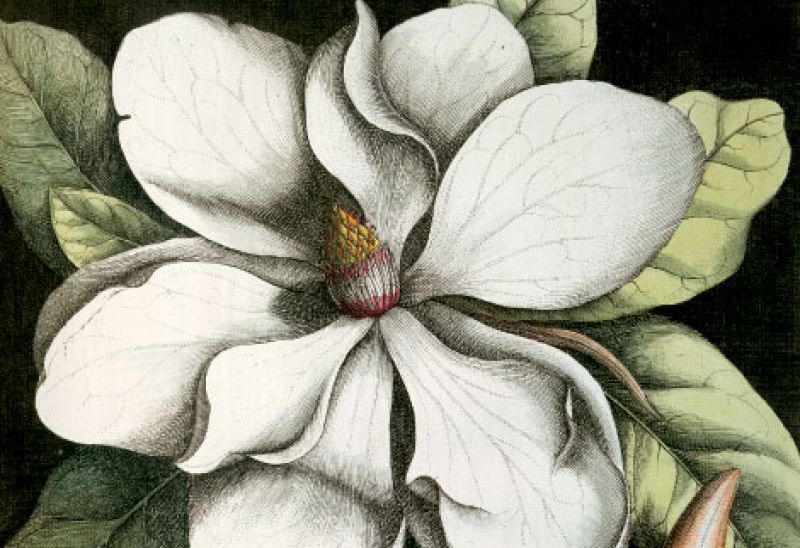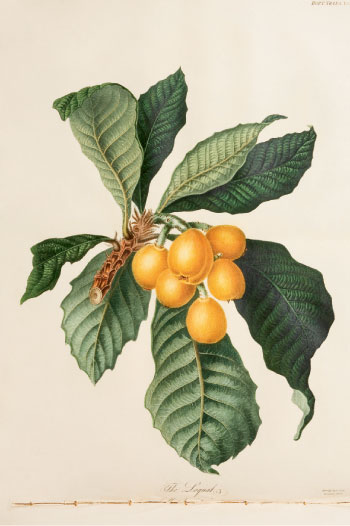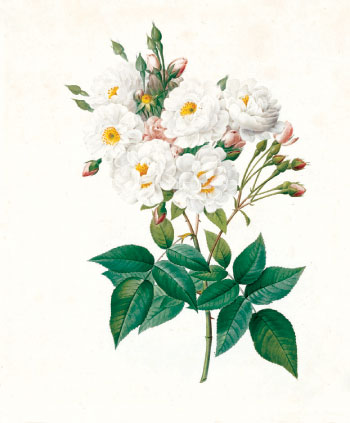
As ships explored still-new corners of the globe in the 18th and 19th centuries, exporting, importing, and recording plants was as much an adventure for nurserymen, botanists, and artists as conquests were for world leaders. In those times, Charleston was a veritable Eden for these bold voyagers to introduce new plants (camellias, azaleas, loquats), catalog existing local flora (magnolias), or ship out the new cultivars they coaxed into being (Noisette roses). World-famous illustrators clamored to capture the likenesses of all these plants, and the results were highly collectible, stunning works that bridged science and art. Here, we take a scrapbook-style garden tour of a handful of favorites from the botanical past that’s lead to our present.
 Camellia
CamelliaPlant Particulars
Regions: Lower, middle, & coastal South
Zones: 10 to 7
Height: 8 to 15 feet
Details: Sasanquas bloom in late fall to early winter, japonicas in late winter through early spring
Conditions: Partial sun in well-drained, moist, acidic soil
Origin: China
Display Garden
Heather Barrie of gathering: floral + event design says that one of the best ways to display short-lived camellias is to simply float them in a pretty dish of water. This bloom is a Lady Charleston from the prolific garden of the late Rupie Drews of James Island.
What’s in a Name?
Carl Linnaeus named camellias after Jesuit priest and botanist Georg Josef Kamela, aka “Camellus,” who first imported the shrub from Japan to the Philippines to Spain more than 300 years ago.
About the Artist
Laurent Berlese, an Italian abbot, established himself as the 19th century’s foremost international expert on camellias thanks to the hundreds of varieties he nurtured in his greenhouses and gardens. He first attempted to classify the evergreen shrubs via color, but abandoned that system later as imprecise because each book had to be hand-painted and the colors naturally varied. He replaced his old strategy with one based on flower form (or configuration) that endures today. Though J.J. Jung, a member of the Royal Society for Horticulture in Paris, created scores of camellia portraits from flowers collected from Berlese’s trove, interestingly enough, it’s the green-thumbed guru himself who’s credited with the famous line of prints.
Local Beginnings
Magnolia Plantation & Gardens’ John Grimké Drayton propagated camellias in the 1800s, giving them names of friends and family. More than 150 camellia cultivars got their start in his gardens, and today more than 900 varieties and 6,000 specimens still thrive at the plantation.
Did you know?
Though records are difficult to procure, it’s thought that the first camellias brought to the New World were planted on the uppermost terraces at Middleton Place in the 1780s, gifts from the famed 19th century gardener Francois André Michaux.
One of the first camellias to be planted in North America—“Reine des Fleurs”—still thrives at its New World birthplace: Middleton Place plantation.
Magnolia Plantation & Gardens John Grimké Drayton propagated camellias in the 1800s, giving them names of friends and family.
More than 150 camellia cultivars got their start at Magnolia Plantation & Gardens. Today more than 900 varieties and 6,000 specimens thrive at the plantation.
Camellias were brought to Europe from Asia in the 1700s, and are believed to have come to America via Charleston in 1786-7, though the first formal records show they appeared in New Jersey in 1897.
The South’s mild winters liberated camellias from the greenhouses that sheltered them in Europe and the Northeastern U.S.
 Loquat
LoquatPlant Particulars
Regions: Lower & coastal South
Zones: 12 to 8
Height: 15 to 30 feet
Details: Evergreen that blooms in the fall and fruits in late spring through early summer
Conditions: Prefers full sun in moist soil when first rooting, dry soil after established
Origin: China & Japan
First Roots
Loquats initially appeared in America in the early 1800s and soon became a favorite in the South, where they thrived in the hot climate.
Singing Past Praises
“The Japan Plum—Eriobotrya (mespilus) japonica—whether as a mere ornamental evergreen, for which it is second to few other, or for the fragrance of its flowers, or delicious fruit, is deserving of infinitely more attention than it has received….”
An excerpt of the Natchez Daily Courier reprinted in The American Cotton Planter, 1855
About the Artist
Renowned in the early 19th century for his fruit portraits, William Hooker portrayed his subjects realistically—spots, bruises, discolorations, and all. The official artist to the Horticultural Society of London from 1812 to 1820, Hooker contributed to Transactions of the Horticultural Society of London, Volume III. To view this book, contact the Charleston Library Society at (843) 723-9912, www.charlestonlibrarysociety.org.
Natural Inspiration
“There is a little girl across the street hanging from the loquat tree
All you can see are her shoes and socks and skirt
The upper half of her body is buried in the leaves,
The branches are shaking, as she reaches up, deep into the tree
For the yellow fruit….”
From “Slick” by local poet Jonathan Sanchez
(www.beingsanchez.com)
 Azalea
AzaleaPlant Particulars
Regions: Middle, lower, & coastal South (Southern indica hybrids)
Zones: 9 to 7
Height: 2 to 5 feet
Details: Evergreen, blooms in spring
Conditions: Full shade or sun to partial sun in lightly acidic, loose, moist soil
Origin: Japan
Festival of Flowers
From 1934 to 1953, Charleston’s gayest springtime happening was the Azalea Festival. For one week each spring as the festival’s namesake bloomed, a parade, beauty pageant, dance, and boxing and golf tourneys consumed the town. In 1972, Summerville took over the tradition, and every April the Summerville Family YMCA Flower-town Festival, a weekend-long art show, is held amid the town’s vibrant, sprawling azalea garden. This year, it’s April 3-5; for the 2010 dates, call (843) 871-9622 or visit www.summervilleymca.org/flowertown.
About the Artist
This lithograph of an Azalea indica (opposite) first appeared in the mid-19th-century botanical book Flore Des Serres et des Jardins de L’Europe (1856). Some of Europe’s finest talents came together to publish the collection of exotic plants and flowers, including Louis van Houtte—the engraver for famed Belgian artist Pierre Joseph Redouté and the head of one of the continent’s most esteemed nurseries—who raised prize specimens like this azalea (opposite) in his hothouses as subjects for cataloging.
Did You Know?
It’s up for debate just where and when azaleas first came to America, but it is widely accepted that by the mid-1800s, the largest collection in the country was at Magnolia Plantation & Gardens (left). One story relays that proprietor John Grimké Drayton came down with tuberculosis and part of his prescription for healing included gardening. Local lore tells that he wanted to endear his Northern-born wife to the Lowcountry and thus planted blooms aplenty. Azaleas also appeared at neighboring Middleton Place (above, center) in the 1840s but truly took off in the 1920s when owner John Julius Pringle Smith ordered some 35,000 specimens planted there.
What’s in a name?
Azalea indica (aka Indian Azalea) suffers from a long-ago misnomer. According to botanical historian Jim Cothran, in the 1800s Asia was known as the Indies, and though the azalea heralded from Japan, it was named after the larger area from when it came. Sensitive to cooler temperatures, the Azalea indica was labeled as a greenhouse plant in most of the world until it came to America’s Deep South, where it thrived outdoors.
 Magnolia
MagnoliaPlant Particulars
Regions: Upper, middle, lower, & coastal South
Zones: 10 to 6
Height: Up to 100 feet
Details: Evergreen that flowers in May and June
Conditions: Full sun to partial shade in loamy, acidic soil
Origin: In 1703, Charles Plumier was the first to name and catalog a magnolia by genus in print; he captured its likeness on Martinique (where the plant was called a “talauma”) and christened it in honor of famed French botanist Pierre Magnol. It is also native to the southeastern United States.
About the Artist
Self-taught artist Mark Catesby visited Charles Towne and Fort Moore (near Beech Island), South Carolina, between 1722 and 1725 to study local flora and fauna. Heralded as the first American naturalist, he captured our environs with etched images that were later published in the highly collectible book The Natural History of Carolina, Florida, and Bahama Islands (right). With it, not only was he the first to record the colonial world with a scientific eye, he also became the first author to print full-color folio-sized images in a naturalist title. To see a copy of Catesby’s rare tome firsthand—including his stunning magnolias—contact the College of Charleston’s Special Collections at the Marlene & Nathan Addlestone Library, 205 Calhoun St., (843) 953-8016, www.cofc.edu.
Decorating Tips
For arrangements, cut magnolia blossoms tenderly, avoiding contact with the easily bruised petals, then place branches into a vessel filled with saturated floral foam. Expect blooms—if kept cool—to last the length of a dinner party. To fashion a magnolia wreath, collect fresh leaves and pin a handful (at the stems) to a saturated floral foam ring. Continue clockwise, layering leaves until the form is fully covered.
About the Artist
Self-taught artist Mark Catesby visited Charles Towne and Fort Moore (near Beech Island), South Carolina, between 1722 and 1725 to study local flora and fauna. Heralded as the first American naturalist, he captured our environs with etched images that were later published in the highly collectible book The Natural History of Carolina, Florida, and Bahama Islands (right). With it, not only was he the first to record the colonial world with a scientific eye, he also became the first author to print full-color folio-sized images in a naturalist title. To see a copy of Catesby’s rare tome firsthand—including his stunning magnolias—contact the College of Charleston’s Special Collections at the Marlene & Nathan Addlestone Library, 205 Calhoun St., (843) 953-8016, www.cofc.edu.
Did you know?
Francois André Michaux said of magnolias in The North American Sylva (1819), “Those who have seen the tree on its native soil agree in considering it as one of the most beautiful productions of the vegetable kingdom.”
 Noisette Rose
Noisette RoseRegions & Zones: Vary by variety, but warmer climes of the South are ideal
Height: Varies
Details: Climbing or shrub depending on variety; blooms from early spring into summer
Conditions: Vary by variety
Origin: Charleston, South Carolina
A Rosy Start
Back in the early 1800s, Charleston gardener John Champneys crossed two roses (a musk and China) to create Champneys’ Pink Cluster. Offspring from that bloom made its way to his neighbor Philippe Noisette, who further cultivated the shrub before sending the ever-blooming, hardy, and fragrant winner to his nurseryman brother, Louis Claude Noisette, in France, where its attributes made it a sensation. When Pierre Josef Redouté painted the bloom at Noisette’s behest, he called it “Rosa Noisettiana; Rosier de Philippe Noisette,” and so a new class of roses came to bear a Charlestonian’s name.
About the Artist
Belgian-born artist Pierre Joseph Redouté found his way to Paris in the late 1700s and eventually became the court artist for Marie Antoinette and then for Empress Josephine. His talents were such that not only did he stand in favor on both sides of the French Revolution, his work is also as fresh today as it was when crafted nearly 200 years ago. Charged with capturing royal gardens, he illustrated several books, one of his more famous creations being Les Roses (1817-1824), in which this Noisette (opposite) appeared. To see—and purchase—his work, visit Audubon Gallery, 190 King St., (843) 853-1100, www.audubonart.com.
Petal Pusher
Sullivan’s Islander Ruth Knopf fell in love with roses while planning a garden some 40 years ago. Since then, she’s become one of the world’s preeminent Noisette rose experts. Knopf oversaw the creation of the antique rose garden at Boone Hall Plantation, assisted with Charleston’s 2001 International Conference on Heritage Roses, and helped city parks horticulturist JoAnn Breland develop the Hampton Park Noisette Study Garden, as well as downtown’s Heritage Rose Trail—an informal path of vintage blooms that wends through the area’s historic churchyards. For more on the Rose Trail, contact the Charleston Horticultural Society, (843) 579-9922, www.charlestonhorticulturalsociety.org.
Back in the early 1800s, Charleston gardener John Champneys crossed two roses (a musk and china) to create Champneys’ Pink Cluster. Offspring from that bloom made its way to his neighbor Philippe Noisette, who further cultivated the shrub before sending it—an ever-blooming, hardy, and fragrant winner—to his nurseryman brother, Louis Claude Noisette, in France, where its attributes made it a sensation. When Pierre Josef Redouté painted the bloom at L.C.’s behest, he called it “Rosa Noisettiana; Rosier de Philippe Noisette,” and so a new class of roses came to bear a Charlestonian’s name.
PLANTATIONS, PARKS, & PRIVATE GARDENS ON TOUR
Boone Hall Plantation: Self-guided tour of the antique rose garden plus the butterfly pavilion (in season). The Strawberry Festival will be held April 18-19, 2009.
1235 Long Point Rd., Mount Pleasant; (843) 884-4371; www.boonehallplantation.com. $17.50; 65+/Military/AAA Members $15; $7.50 children; children ages five and under are free. Admission also includes entry to the plantation, The Plantation Tram Tour, “Black History In America” Exhibit, Slave Street & History Tour, Plantation House tour, “Exploring The Gullah Culture” (in season), and parking. Open March 9 to Labor Day: Monday-Saturday, 8:30am - 6:30pm; Sunday, 1pm-5pm.
Flowertown Festival: The weekend-long art show and family-style festival is held at Summerville’s vibrant, sprawling Azalea Park from April 3-5. For the 2010 dates, call (843) 871-9622 or visit www.summervilleymca.org/flowertown.
Hampton Park: A 63-acre neighborhood park with a two-acre lagoon surrounded by beds planted with roses, azaleas, camellias, and the Noisette Study Garden. Cleveland St. off Rutledge Avenue downtown. Open: Daylight until dark.
Magnolia Plantation & Gardens: The oldest unrestored gardens in America includes thousands of azaleas as well as flowering fruit trees, spirea, iris, anemones, Icelandic poppies, roses, lilies, redbud, wisteria, and others, offering a magnificent spring bloom. 3550 Ashley River Rd., Charleston; (843) 571-1266; www.magnoliaplantation.com. $15; $10 children ages 6-12; children ages five and under are free. Admission gives visitors access to the main gardens as well as the Swamp Garden, Barbados Tropical Greenhouse, the Horticultural Maze, and the Wildlife Observation Tower. Open 365 days a year, including holidays, from 8 am until dusk (March through October).
Middleton Place: 65 acres of landscaped terraces, shadowy allées, ornamental ponds, and garden rooms laid out with precise symmetry and balance.
4300 Ashley River Rd., Charleston;
(843) 556-6020; www.middletonplace.org. $25; $5 children ages seven-15. Admission includes access tot he gardens and the working Plantation Stableyards, as well as an African American Focus Tour, Nature Walk, and Garden Overview Tour. Open daily at 9:00 am.
Heritage Rose Trail—an informal path of vintage blooms that wends through the area’s historic churchyards.
Charleston Horticultural Society, (843) 579-9922, www.charlestonhorticulturalsociety.org.
Through April 18
The Festival of Houses & Gardens
On display are more than 150 private homes and gardens, hailing from 11 historic neighborhoods on the peninsula. Each tour takes guests through eight to 10 properties, offering a rare glimpse inside colonial and antebellum interiors or gardens at the height of their blooming season. Also on the schedule are luncheon lectures on a variety of historical, gardening, and decorating topics. Various locations & times. $45. (843) 722-3405, www.historiccharleston.org
April 13 & May 11
Charleston Horticultural Society Lectures
Start each month with informative garden gab! On April 13, catch Andy Cabe, curator of horticulture at Riverbanks Botanical, leading “Living the Lush Life: Exotic Perennials that Beat the Heat.” During the May 11 lecture, Greg Paige, curator for Bartlett Tree Research Arboretum, offers year-round advice in “Gardening for All Seasons: Planting and Maintaining a Healthy Landscape.” Charleston Museum Auditorium, 360 Meeting St. Monday, 6:30-7:30 pm. $15; free for member. (843) 579-9922, www.charlestonhorticulturalsociety.org
APRIL 19
Historic Old Village Home, Garden, & Art Tour
Spend a spring Sunday in one of the Lowcountry’s most charming neighborhoods, the tree-lined, waterfront Old Village Mount Pleasant. For this special event, visitors are welcomed into some of the neighborhood’s finest homes and gardens for a leisurely tour, while an art sale showcases the talents of Mount Pleasant artists. All tour proceeds and a portion of the artists’ sales benefit the American Red Cross Carolina Lowcountry Chapter. Pitt St., Mount Pleasant. Sunday, 1-5pm. $45. (843)764-2323 ext. 355, www.lowcountryredcross.org
APRIL 25
Plantasia
Grow your garden on a budget at this green market, offering a giant selection of tropicals, annuals, perennials, flowering shrubs, and more. Find everything from favorite Southern plants to exotic and hard-to-track-down cultivars, with horticulturally trained volunteers on hand to aid in plant selection. There’s even an entire section of used garden tools and accessories. All proceeds fund Charleston Horticultural Society programs. Gaillard Auditorium, 77 Calhoun St. Saturday, 8am. Free admission. (843)579-9922, www.charlestonhorticultural-society.com
April 25-26
Diggin It! Spring Garden Festival & Plantacular Sale
Still searching for that rare tree or coveted flower? The search stops at Brookgreen Garden’s annual Diggin’ It! event, which puts the “for sale” sign on hard-to-find plants straight from Brookgreen’s own greenhouse. The event also features speeches specifically aimed at gardening in the coastal South.
Brookgreen Gardens, 1931 Brookgreen Dr., Murrells Inlet. Saturday & Sunday, 9:30am-8pm. $12; $10 senior; $5 ages six-12; free for member & child five & under. (843) 235-6000, www.brookgreen.org
GALLERIES & SPECIAL COLLECTIONS
Audubon Gallery, 190 King St., (843) 853-1100, www.audubonart.com
Charleston Library Society at (843) 723-9912, www.charlestonlibrarysociety.org.
College of Charleston’s Special Collections at the Marlene & Nathan Addlestone Library, 205 Calhoun St., (843) 953-8016, www.cofc.edu.